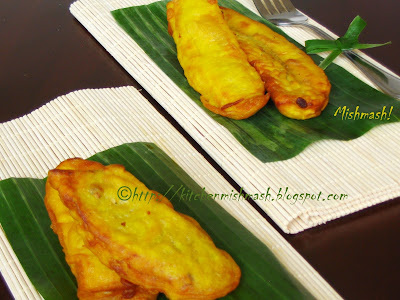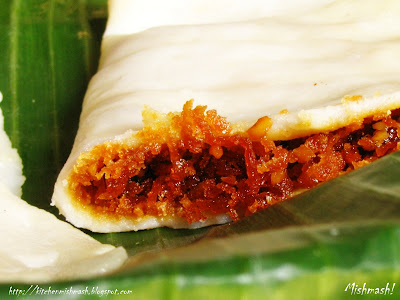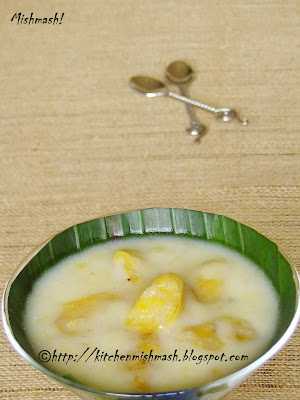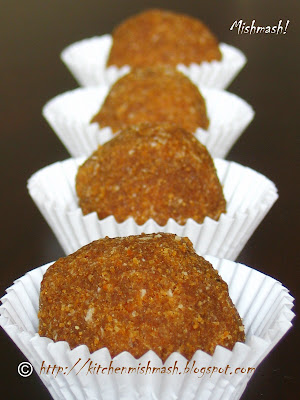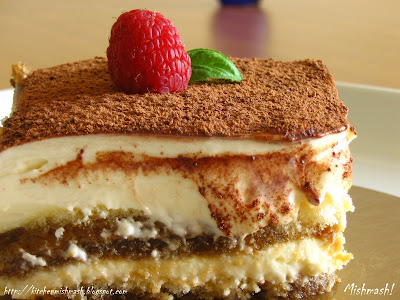
Last week I happened to read Ann’s evocative post, reminiscing her childhood days spent at maternal ancestral home and her story took me right back to my maternal home where I loved spending most of my childhood and adolescence. Nevertheless, what struck me most was the part where she painted the picture of her grandparents waiting for their arrival……….I knew exactly what she was talking about as that was more or less the same picture at my paternal ancestral home too. The only difference was that we didn’t have a grandmother waiting for us, instead Achichan/grandpa and a quarter dozen of my aunts and uncles and my little cousins waited for us. The smile on their faces and warmth in their eyes was always heart warming and inviting. My grandfather was a handsome old man, wheat complexioned with almost 6 foot height and a large round belly and a Rudraksha-maala/beaded chain around his neck and if it was his bath day, the gracefulness on his face doubled with that triple layer Chandana-kuri with a round kunguma – pottu on his forehead and some more chandanam/sandal paste smeared on his arms and chest, giving him an aristocrat regal look.
As we stood at the verandah talking to them, the irresistible aroma of roasted coconut simmering in Kadala/black chickpeas Curry wafting from the kitchen, circled us magically. In minutes we were served breakfast with Puttu, Kadala Curry, steamed ripe plantains and a glass of tea for my parents and uncles and a glass of milk flavored with an extra spoonful of Bournvita for us kids. Food was the expression of love in that house and for the same reason, each of my aunts always prepared something special for our visit…sometimes it was the grainy avalose podi or Aval Vilayichathu, a sweet snack with rice flakes and jaggery or Sughiyan, deep fried sweetened lentil fritters and if an aunt forced us a bit more to eat one particular snack from that list, it was a clear indication for us to learn that she made it :)
By the time we finished having breakfast and changed to household clothes, the activity at the kitchen would be at its full swing. My mother along with one of my aunts would start chopping vegetables for lunch, sitting on top of Ari-petti, a wooden storage box to store rice and lentils. Sheeja chechi & Usha chechi, two young maids would be either cleaning fresh fish or grating coconut at the work area of the kitchen. When two wood burning stoves and gas burners were in full action, one of my aunts would slowly move to Viraku-pura/wood storage area which was earlier called Achichan’s Marunnu-pura ( a place to make medicine) when he was practicing Ayurveda. She would start setting up a temporary Aduppu, a wood burning stove to start making one of our favourite Payasam. I always stood on the steps of Viraku-pura watching my aunt stirring payasam with a chattukam in a big Uruli, a wide mouthed bell metal vessel. I was hesitant to go inside as I had heard about few instances of spotting some unwanted visitors who slither!! :-O
Next to Viraku- pura was a Kozhi-koodu/hen house, on a 5 foot four legged concrete pedestal but at one point of time, the actual residents were some rabbits! At old age, Achichan wanted some new pets, I guess :) Right next to that one was our favourite place, Kulam…..with my brother, I remember trying to catch small fish, holding a cheese cloth like thorthu from two sides :) There was also a motor shed adjacent to Kulam as water was pumped from this pond to water the coconut tress and other plants and water was navigated through a narrow handmade sand canal which we called, kaiyyani. All of us cousins have got scolding atleast once in our childhood for playing in that water and walking through Kaiyyani because if we broke the edges, it would act like a broken levee and water would leak into unwanted areas. Mostly my uncles or their assistants, Chandra chettan or Sukumaran chettan would be in charge of opening and closing these small canals with a shovel. That motor shed served another function too, it also acted as the place for hiding everything from X X X Rum to McDowells to Honey Bee to toddy as my father and uncles never wanted to let their father or anyone know about their little ‘indulgence’ as they played few rounds of 28 or rummy :P
With the canopy of coconut leaf fronds our yard,Parambu had a myriad of trees yielding everything from jackfruit, mango, coconut, breadfruit, plantain, papaya, banana, nutmeg, tapioca, Kudam-puli, jambakka etc etc….It was under the jambakka tree in the front yard, that we had our Oonjal/swing….not the ones you see in parks…this one was different….a thick coir thread was tied to a sturdy branch of the tree and seating was not any iron or wooden planks….ours was an organic one , the base or the thick part of coconut palm fronds cut into a decent length with a V shape on its edges to lock in the coir thread and voila, we had our swing :) When it was season, with every blow of wind, jambakka fell on the ground…….. though only a 10 or 12 year old , the decorator in me always rose to the situation and decked Achichan’s Shoola-thara/ a holy spear installed on a concrete pedestal, with a raw of those tiny white fruits and it did appear like a small house lit up with a row of lamps on the eve of Deepavali. But Achichan always got furious seeing this as he just could not tolerate his grand daughter showing disrespect to a place where he prayed and did some pooja every day during his entire adulthood. :D
My grandfather was quite a religious man deeply involved in rituals and prayers and hence our ancestral home was a classic example of a Hindu household where the colourful rituals of Hinduism drained an unimaginable portion of family wealth. Whether I consider such rituals superstition or not, I was lucky to witness such pooja and homam being performed at my paternal home, by 5-6 priests with a Homa-kundam/sacred fire in the centre and a colourful kolam of a goddess drawn out with precision and art at its best. For me such occasions not only gave me a peek into such colourful rituals but also were an opportunity to meet our entire big family. On such days the house was epitome of action…women were busy in kitchen , cleaning up brass mugs and plates for pooja, cooking up vegetarian feast with utmost carefulness to feed the priests, cousins in charge of collecting flowers and separating petals from lotus flowers and men going to the market to buy last minute essentials…and by evening air would be filled with mantra/prayers and songs recited by priests and at night all of us sat around the sacred fire and basically threw whatever flowers we were handed to , into the homa-kundam/sacred fire and the naughty ones laughed softly when one of the aunts had a bad gastric problem caused by the parippu-curry she had for lunch! :)
When I look back, everything looks like from a totally different era altogether. That old house had been demolished and a new one is there in its place….Achichan passed away long back…… Shoola-thara has been removed and transported to our family temple…………….joint family has become single units though in the same yard itself…….when I called last weekend my little cousins are now all grown up and preparing for board exams and university exams but what still remains is that smile on their faces and warmth in their eyes and the table that continue to be the expression of love with the huge array of food presented each time we visit and the laughter in the house and gossip in the kitchen and ofcourse, Honey Bee in the motor shed too but I have been missing all that for last few years, like a typical NRI !!!
Ann did stir up a tsunami of thoughts in my head!
Kadachakka Puzhukku is a mushy preparation with overcooked breadfruit mixed with mildly spiced ground coconut mixture and my father recalls that it was a regular at home during the breadfruit season. It is usually served as a side dish for lunch but it is a tasty combo when served with Kanji, rice soup for dinner. Though Puzhukku (mashed version) and thoran/stir-fry are technically two different things especially in terms of texture, the same ingredients and methods are used to make a dry stir-fry/thoran with kadachakka/breadfruit. For Puzhukku, it is ideal to have a slightly overcooked Kadachakka/Breadfruit to get a mushy texture for the dish whereas in Thoran, you should make sure that Kadachakka/Breadfruit is just cooked till tender, to have a dry stir-fry texture.
Ingredients: (Approx.)
For cooking:
- 2 cups Kadachakka/Breadfruit, cubed (after removing the green exterior)
- ¼ - ½ tsp turmeric powder
- 2 Indian green chillies, split lengthwise
- 1 ½ cups water or enough to cook Kadachakka/Breadfruit
- Salt to taste
For crushing:
- ½ - ¾ cup grated coconut
- 2 small red pearl onions, finely chopped
- 1 small clove garlic, minced
- 2-3 green chillies, chopped
- ¼ - ½ tsp turmeric powder
- A small pinch of cumin seeds/jeera
- Salt to taste
For seasoning:
- 1 tbsp coconut oil
- 1 tsp mustard seeds
- 2 dry red chilly
- 1 sprig curry leaves
Directions:
- Cook cubed pieces of Kadachakka/Breadfruit with green chillies, turmeric powder, water and salt, on a stove top, in a sauce pan, until pieces are done and soft, in low-medium heat. To save time, you may also cook Kadachakka/Breadfruit in pressure cooker, until the first whistle comes. Then turn off the stove and let it rest till the steam subsides.
- Meanwhile, prepare the coconut mixture. Crush and blend the grated coconut well with finely chopped small onion, green chilies, turmeric powder, cumin seeds and a tinge of salt (do not add more salt here as you have already added while cooking Kadachakka/Breadfruit ), using your hands OR a mortar-pestle set OR put all the ingredients in a small food processor and pulse 1-2 times.
- In a shallow pan, heat coconut oil, splutter mustard seeds, dry red chilly and sauté curry leaves for 30 seconds. To this add the ground coconut mixture and mix everything well and cook in medium heat for a minute, stirring occasionally. Now add the cooked pieces of Kadachakka/Breadfruit to this and gently mix everything together and let it sit in low heat for a minute or two. Do a taste- test, adjust the salt and turn off the stove
- Serve with Kuthari Choru or Kanji
Note: For Puzhukku, it is ideal to have a slightly overcooked Kadachakka/Breadfruit to get a mushy texture for the dish whereas in Thoran, you should make sure that Kadachakka/Breadfruit is just cooked till tender, to have a dry stir-fry texture.
Related Posts:

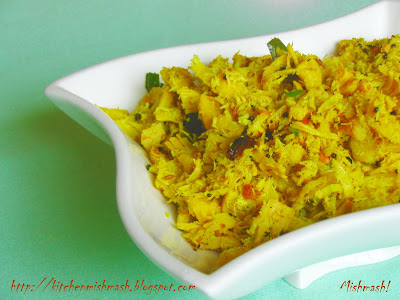
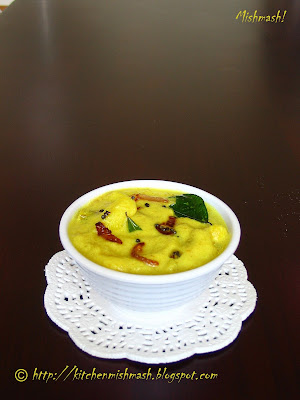
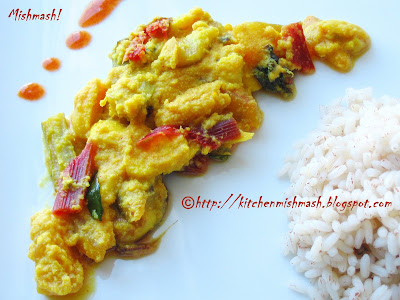

Luv
Shn

